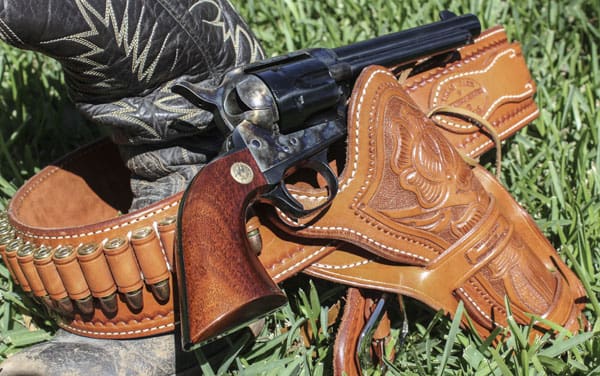
(This post is an entry in our spring content contest. If you’d like a chance to win a Beretta APX pistol, click here for details.)
By Gene H.
I’ve been married over thirty years now and they’ve been the best thirty years of my life. We adopted our children and the cost of that adoption limited my ability to spend money on things like guns, ammunition, and hunting. But then our kids were gone and I finally found the time and money to spend on the things I wanted to do.
First on the list was buying guns and all the fun stuff that goes with that. I’ve made some progress on the purchasing front, but I don’t yet have an arsenal because all of what I have will still fit into a single gun safe. By my definition, I’ll have an arsenal when I have to buy another safe to store my objects of pleasure.
Last year, when I won a university teaching award that included cash along with the requisite shelf hardware, the question wasn’t whether I would buy a gun, but rather what gun would I buy (note to readers: yes, I am a university faculty member that owns firearms and believes in the Second Amendment – such a creature does exist).
I knew that my kids wouldn’t keep the shelf hardware after I pass away, but they would probably fight over which of them would get the gun that represents their father’s impacts on his students. I wanted this firearm to be a keepsake, but it also needed to be something more than a safe queen. I wanted something with some historical significance, not the latest polyester polymer firearm with a super-duper light-bending and self-correcting aiming mechanism guaranteed to make a hole in the target.
The more firearms I have acquired, the more I have come to appreciate the historical value of older gun designs. While I enjoy shooting my newer guns, it’s the ones that have a long pedigree that I enjoy the most. My 1911, my father’s Remington Model 511 22 caliber, and my grandfather’s Winchester Model 1897 12 gauge.
I finally decided I wanted a six-shooter similar to what John Wayne wore on his hip (AKA Single Action Army, SAA, Peacemaker, Colt .45, or M1873) and started looking at the options. I know I wanted a new pistol, not one that someone else was the first to buy. The choices can be overwhelming.
A true Colt Single Action Army was not under consideration due to availability, price, and reputation. I looked at a lot of other options and the Ruger Blackhawk, Ruger Vaquero, and Urberti Cattleman quickly rose to the top of my shopping list. While visiting my LGS, they asked if I knew about Cimarron Firearms, a Texas gun company in Fredericksburg.
Being a native Texan, I liked the idea of getting my pistol from within the borders of the Republic. As I did my research, I found that Cimarron has a history of providing replica firearms, especially for movies. Their website includes the following about the SAA:
“Considered as the most authentic and highest quality reproduction of the 1873 Colt, Cimarron’s replica was reproduced in every detail from an original 1873 single action in our antique collection, and was not replicated by working simply from drawings, as with previous reproductions. We also took extra steps to improve the gun’s reliability with our Cowboy Comp® action which eliminates weaknesses associated with the 19th century design.”
So the manufacturer was decided, but then the hard work began. There were three different decisions to make: the model, caliber, and barrel length. The choices of SAA revolvers from Cimarron were daunting, with no less than ten different models. After a couple of calls to their retail store, Texas Jacks (see JWT review), I learned that the classic SAA boiled down to a choice between the Model P Old Model (1873-1896) or the Model P Pre-War (1896-1940). The main difference between these is the ease in removing the cylinder. I finally decided to get the Pre-War model so that I could remove the cylinder without having to use a screwdriver.
Next up, revive the caliber wars! The Model P Pre-War revolver is available in six calibers: 32 WCF, .357 Magnum, 38 WCF, .44 Special, 44 WCF, and .45 LC (.45LC also available with a .45 ACP dual cylinder). I originally wanted my SAA to be a 45 Colt to be truer to the early use of the pistol, but after visiting a local Cowboy Action Shooting match, I learned that the .357 Magnum is much better for competition shooting due to the lower recoil of the .38 Special that can also be used with that caliber. As my ultimate common use for this pistol will eventually be CAS, I decided to go with the .357 Magnum.
The really hard decision was barrel length: 4¾ , 5½, or 7½ inch. I had no experience with barrel lengths longer than 5 inches, and with no other information to help me choose, this was a toss-up. I finally split the difference and went with a 5½ inch barrel. I knew I wasn’t going to be trying to win any quick draw contest, which is where the shorter barrel length has an advantage and I didn’t want to try drawing a long-barreled pistol from a holster.
Having finally made the choices, I ordered the Model P Pre-War 5½ inch barrel in .357 Magnum from the LGS and it arrived within a few days. MSRP was $539.50 and I got mine for $489.00. Unlike all the other pistols I’ve ever bought, this one came in a cardboard box, not a plastic case. The pistol was wrapped in plastic with a generous coating of oil throughout. The box contained the usual operator’s manual, promotional material (including a bumper sticker), and a sample packet of Ballistol (a product I swear by).
Overall Appearance
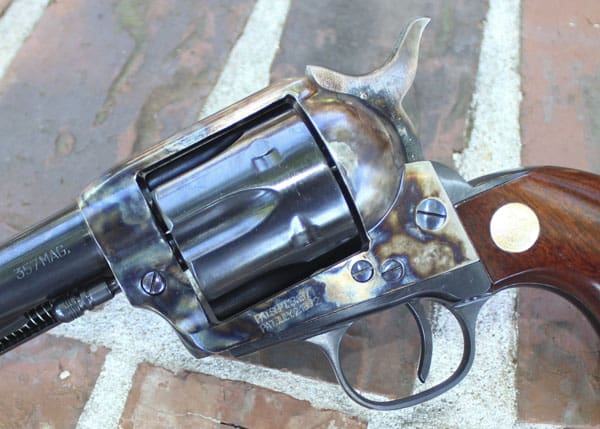
This is a beautiful gun, the best looking one in my safe. First, it has the classic lines of a Single Action Army. The frame is case-hardened steel. The barrel and cylinder are blued steel. The grip is smooth walnut. When combined with the holster and cartridge belt I bought from Texas Jacks, this is a great BBQ gun.
Features
If you are looking for all the latest technology wrapped up in the newest firearm, this is not the gun for you. In the 1870s, this firearm was state-of-the-art. It served as the standard U.S. military service revolver from 1873 until 1892.
The front sight is a fixed blade. The rear sight is a notch in the top of the receiver. It is single action only, meaning you have to cock the hammer each time you want it to go bang. You reload one cartridge at time and unload the same way.
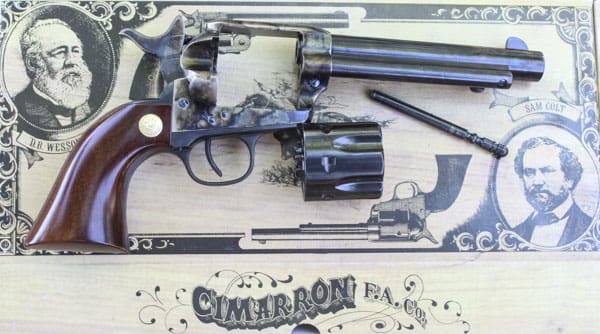
It field strips to three parts: the frame, the cylinder, and the cylinder pin. Field stripping is where the Pre-War Model has the edge over the Old Model, as you can release the cylinder pin with the press of a button. The cylinder pin can be a little obstinate to remove at times, but seems to be getting easier with each removal and with liberal use of Ballistol. Disassembly consists of removing the cylinder pin, opening the loading gate, and taking out the cylinder.
Growing up watching westerns, I always thought that cowboys had six cartridges in their six-shooters. Not true. Turns out that the safety for this gun is to drop the hammer on an empty chamber. To do that, you load one, skip one, then load four.
With the Pre-War Model, you have the option to push in the cylinder pin extra notch to keep the firing pin from contacting a primer. Getting the cylinder pin back to the normal position for firing is not an instantaneous event – at least for me, it takes some finagling. While the smooth walnut grips look great, I’ve found myself wishing for some checkering on hot Texas days at the range when my hands get sweaty.
Ease of Use
This gun could not be any easier to use. The hammer has four positions: 1) firing pin contacts the primer, 2) firing pin off the primer (about a ¼ inch away from the primer but not recommended for carrying with a cartridge in the cylinder), 3) half cock for loading and unloading, and 4) full cock and ready to fire.
To load, you put the hammer in half cock, open the loading gate and insert the cartridges one-at-a-time. To fire, cock the hammer and pull the trigger. To empty, put the hammer in half cock, open the loading gate, and press the ejector rod to push the empty cartridge out of the cylinder (again, one-at-a-time). It is slow and methodical, but keeps you from blowing through ammo at the range.

Accuracy
But history and beauty go only so far in a firearm. The big question is how it would shoot. The answer is very well, at least with .38 Special ammo. The recoil with the .38 Special cartridge is light, reinforcing my decision to go with that rather than the .45 Colt.
The photos show some of my five-shot groups freehand, with a rest, and for two other pistols (grid is 1 inch). The trigger pull is extremely light and it breaks cleanly with little take-up. I don’t have a way to measure trigger pull, but it is a fraction of that for any of my semi-automatic handguns. It is so light, that I continue to struggle with getting a consistent grouping, as flyers are not uncommon. The balance of the 5½ inch barrel is good. The classic lines of the grip are a little short for my normal sized hand. Those with big hands may want to go for the Bisley model.
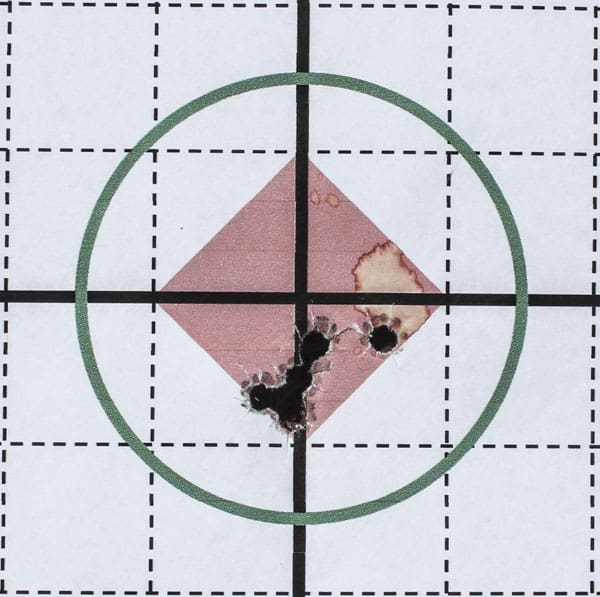
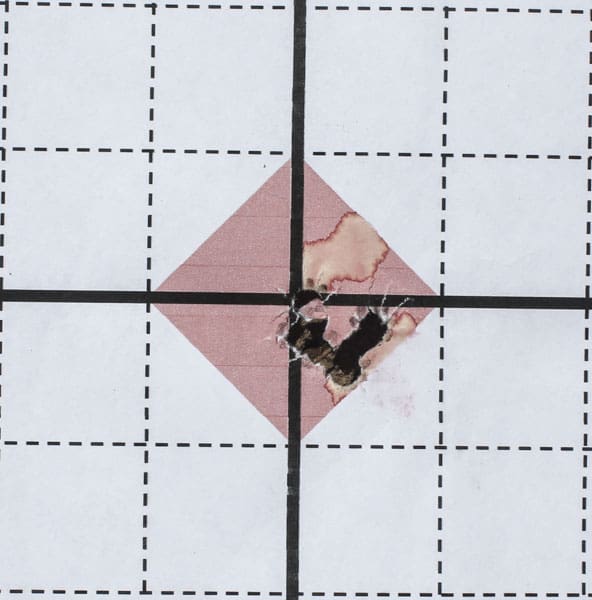


Reliability
This pistols still has less than 1,000 rounds, so I can’t offer much perspective on the reliability of the firearm. But given that it has been in production for most of the past 143 years, I think the reliability speaks for itself. I have not experienced any hiccups so far.
Final Thoughts
I have bought a few guns that had to grow on me before I really embraced the firearm. This is not one of those. No buyer’s regret here. I rarely take the same firearms to the range two times in a row, but this will be the gun that goes on every range trip. I just can’t get enough. It is a great change-of-pace from my other pistols and provides a historical reference point that helps me to appreciate how much the science of firearms have advanced since the days of the Old West.
I rate this pistol five stars in several categories because of what it represented at the time it was new. It is my new favorite pistol. I just need to get one more and a lever action so I can start competing in cowboy action shooting events. When I started this quest for a SAA, I knew I would end up with two for CAS competition, but only wanted to buy them one at a time so that my second choice could improve on the first choice. My best endorsement of this pistol is that I will by the same model as my second pistol.
Specifications:Cimarron Firearms Model P Pre-War Model (MP 401)
Caliber: .357 Magnum (also shoots .38 Special)
Capacity: 6 rounds
Weight (unloaded): 2.58 lbs.
Overall Length: 10¾ in
Width: 1½ in.
Barrel Length: 5½ in.
Barrel Twist: 18¾ RH
MSRP: $539.50, Purchase: $489.00
Ratings: (Out of five stars):
Historical Significance: * * * * *
Style: * * * * *
Accuracy: * * * * *
Ergonomics: * * *
Reliability: * * * * *
Based on 143 years of experience with the firearm.
Customization: *
Fun Factor: * * * * *
Use for Self-Defense: *
Better than no gun, can use as a hammer when empty.
Speed of Reload: 0 stars
Overall: * * * * *
This is not a self-defense weapon and the ratings consider that.



“Being a native Texan, I liked the idea of getting my pistol from within the borders of the Republic.”
Cimarron imports Uberti and Pedersoli firearms from Italy. They are built to higher specifications for Cimarron than other companies as part of their contract.
“They are built to higher specifications for Cimarron than other companies as part of their contract”
I keep hearing this but I don’t know what it means. The last Uberti I bought was just as nice as another one that had the Cimarron branding. The best reason to buy a Cimarron is that when your hand spring breaks (and it will) they will send you a free replacement.
“They are built to higher specifications for Cimarron than other companies as part of their contract”
That means nothing. Higher specifications doesn’t mean tighter or closer specifications or tolerances.
I have a Taylor’s Smoke-wagon Deluxe and it is a very fine revolver.
The Smoke Wagon has a factory tuned action and checkered grips that are not available on the lesser guns. (And yes, it is a fine gun.) Go to your local gun store and cycle the action on one of the regular versions, and you will likely find it to be rather gritty, very unlike the Smoke Wagon, and which is why you pay more for the latter.
@ Mark N.
Funny you should say to evaluate the difference between a Smoke-wagon deluxe as a regular Smoke-wagon because that is JUST what I did! I have the 4109DE and while I was at the LGS, I spied another Smoke-wagon like mine, just not factory tuned like the deluxe is. Big difference, especially in the trigger. Honestly, my Deluxe has the finest trigger of any firearm I have ever owned or felt. Taylor’s does a damn fine job on that tuned edition.
I think the principal differences are in the case hardening (the Ubertis tend to be rather dull looking) and in the special medallions in the grip that are not available on Ubertis.
Thx for review. I’m gonna buy one not that I need another… addiction affliction!
JG
I love my 1863 Cattleman by Uberti in 357 with the 7.5 inch barrel . I love shooting it and the 38’s are easy on an old mans wrist , the 357’s leave my wrist a little sore after a half box but who plinks with 357 , right ?
Great review. I love my one and only revolver and would love to pick up another one. I am very tempted to get a replica of a classic just such as this.
” yes, I am a university faculty member that owns firearms and believes in the Second Amendment – such a creature does exist”
Good to know others exist.
There are a few out there. I don’t think I’ve ever heard of one in the arts/humanities, though. If you’re a Second Amendment believer in that area, you’re a rare one indeed.
Yeah UND and U of M, Crookston (UMC) have or had at one point a few who were pretty ambivalent (which in the arts/humanities is a win)… but in general most are pretty much hippies.
The good news is in the hard sciences/history there have been major improvements to vet the last 10-15 years (I.e. I’m a spouse and have people asking me for thoughts on particular models and ammunition availability/cost).
Glad you like your new pistol. Just understand that it’s made in Italy. Nothing wrong with that as I like Italian stuff myself. It won’t rise anywhere near the collectibillity of a Colt, which is great. When you pass it on to your children, they won’t be afraid to take it to the range and try it out. I myself don’t usually get anything that’s considered ‘collectable’, so an Italian SAA is on my list of what to get while I don’t even consider getting a Colt SAA.
Except that the Colt will still be functioning fine for your grandkids while the Italian phony will have long been relegated to the scrap heap…..
Your comment assumes that you can find an original Colt for sale and also assumes that he is willing to spend $1,500-$2,000 to make his heirs happy.
I have been drooling over this same revolver or the Ruger Blackhawk Convertible so I can shoot dirt cheap 9mm.
How do these 2 pistols compare?
The Blackhawk has a differently shaped frame, which to my eye was always “off” compared to a SAA. [The Vaquero is closer to a SAA.] Second Ruger has a transfer bar safety, and it has eliminated the “dreaded hand spring” (a spring that just loves to break) with a coil spring and plunger–a very different and far more reliable design. I haven’t checked, but the Ruger probably costs a bit more. The MSRP on the Italian clones hovers just north of $500, but they can be found for a hundred dollars or more off on GunBroker (where I’ve purchased two).
Depends on what you want/ from the gun. The Colt clones are great if you want historical accuracy & ‘that look’. The convertible Blackhawk if you want to shoot a truly diverse range of ammo. The Ruger Vaquero if you want some of that look but in a modern firearm that is drop safe with all chambers loaded (same with Blackhawk). In any case the 38/357 chambering is most versatile.
There’s nothing wrong with the Italian made copies of the SAA, most are well made and look great. If there was a specific gun that wasn’t available from an American manufacturer I wouldn’t hesitate buying a gun made by Uberti.
Most of the Ruger Blackhawk’s are larger frame gun with adjustable sights made to handle much higher pressures. There are also a few “flat top” Blackhawk’s built on the smaller “New Vaquero” sized frames currently being made.
If you are set on the smaller frame you are fortunate in that right now you can buy a stainless Ruger Blackhawk Flat Top Convertible built on the smaller SAA size frame in .38/.357 and comes with the 9mm cylinder if you want something on the smaller frame. It’s a Lipsey’s Dealer Exclusive available now Model #5247 but like all dealer exclusives they don’t stay in the lineup permanently. If it’s something you want it’s best to search one out ASAP before they are gone. They may be produced for 6 months or 3 years, there’s no way to know. Lipsey’s offered a blued New Vaquero .357/9mm convertible several years ago but they are long since out of production and all but impossible to find on the used market.
If you aren’t limited by the frame size there are full sized blued or stainless Blackhawk Convertibles in .357/9mm available in just about any barrel length you want. I own a Blackhawk Bisley Convertible in .45Colt/.45acp and I’ve come to love the convertible models. I also own a New Vaquero Bisley in .45 Colt that is also an absolutely fantastic “six gun”. Altogether my sister and I own five Ruger “six guns” and I highly recommend them. I prefer the Ruger’s over all others myself because they are stronger, safer (transfer bar that allows safe carry of 6 rounds) and, of course, are made in America.
Don’t sell the single action short for self defense. While I wouldn’t want to go to war with one I think its certainly adequate to handle any trouble I might find myself in.
Hey! Single action revolvers were just fine for going to war from the 1840s through the 1890s!
Think again. Single action revolvers are for fun, not self defense, period, end of story.
Editorial clarification: I wanted to clarify what each of the targets represents. All were shot at 7 yards. From top to bottom: Cimarron SAA freehand, Cimarron SAA with rest, Sig P320 Compact freehand (3.9 inch barrel), and Model 1911 freehand (5 inch barrel).
Let’s talk customization. For one, there are action jobs–these pistols, except for the factory tuned Smoke Wagon and similar, can be a bit rough. You can have it professionally done, or with a little larnin’ on the interwebs you can learn how to do it yourself. (It’s not very hard to get a gun performing very smoothly.) Second, the Ubertis and Piettas come with plain walnut grips with no shine to them. A great project for sandpaper and Tru-Oil. Or you can go shopping for replacement grips. Hogue makes a checkered grips, but AFAIK, none of the manufacturers offer their own checkered grips (that they put on their high end pistols) as an after market accessory. Or you can go with faux ivory or other custom grips. The best product I’ve found is from Tombstone Grips, but these come as a kit that you have to do extensive sanding, shaping, and polishing to complete. (I had a great time doing it as an evening project, but it is messy.) Finally, for those with big hands, get yourself a Colt 1860 Army clone as cheaply as you can find it and swap out the grips. The 1860 grips were longer, apparently because the .44 had more recoil that the .36 cal predecessors, but for reasons unknown to me, these longer grips were not offered by Colt on the even more powerful .45.
Or you can skip all the work and buy a Ruger or Colt and spend time at the range shooting instead.
Clark, I have both, a .45 Colt Ruger Blackhawk, convertible to .45acp, and two cap and balls. I also built an 1860 from a kit, the experience was worth it, although the kit was rough and required filing, grinding etc. It worked out beautifully. The cap and balls are a different kind of fun from Blackhawks, and are worthwhile to own. Neither substitutes for the other, really. It amounts to what sort of experience you want.
I own six Italian clones, four of which are cap and ball, and two of which are 1873s, one in .38/.357 with a 7.5″ barrel and one in .45 Colt with a 4 3/4″ barrel. The “cowboy action loads” in .45 Colt are actually quite light, sending a 200 grain bullet out at only 750 fps, so the recoil is not particularly heavy. The down side is that these rounds often go for $.60 per round or more, but the upside is that they are easily reloadable, even with a Lee Loader, and the brass tends to last quite a while. And you can also load them with black powder or substitute, soft or heavy as you please, from 28 grains (by volume) up to 40 grains.
My favorite for style is an 1862 Colt Pocket Navy (5 .36 cal rounds, small frame), but I have already broken two hand springs and the action is stiff. (Uberti) My favorite for all around handling is my 1873 in .45 colt, which has a very slick action and sports faux ivory grips. (Pietta, with transfer bar safety.) The transfer bar is a bit clunky (when the trigger is released, there is a distinct double click in the trigger from the transfer bar dropping down), but the gun is dead accurate.
For a ‘beginner’ your initial choice was a good one. While there may be ‘equals’ to Cimarron’s ‘Colt clone’, when someone says ‘their cowboy gun’ brand’s better likely to start a ‘discussion’ (cowboy’s don’t have no real arguments). Take it from someone who’s shot every cowboy gun out there in the past forty years, beginning with Ruger’s Blackhawk and working up to REAL Colt’s (pair 4-3/4″ and 12″ Buntiline special who’s tack-drivin’ qualities made up for time lost drawing from your holster in SASS Cowboy Action Shooting match), going back to pair highly customized engraved pair of Ruger’s Vaquero that turned into period gun like Cimarron’s 1872 Open Top in 44 Colt (Texas Jack even set aside a rare 1873 Short Rifle in 44 Special for this cowboy,, noting the 1873 can be made to shoot the shorter 44Colt) providing this Dark Stuff shooter (black powder) with ‘real period correct’ firearm set.
The guns didn’t stop there; just as the trail of folks shooting Cowboy Action under SASS (Single Action Shooting Society) continues on, a family shooting sport, ages 12 to 82, with the best group of people you can find anywhere in the shooting sports. Cowboy Action Shooting is hands down the most fun you can have with your clothes on- you get to shoot real guns and live whatever cowboy fantasy that you choose, under your own personal SASS ‘Alias’. You like firearms? Just think of it- you’ll need two handguns, a pistol caliber rifle, and a shotgun for the MAIN Match; then there’s Long Range rifle (single shot or lever gun), pocket pistols, derringer, and more to shoot the ‘Side Matches’. That’s MORE guns ‘n gear to buy; hopefully the buying is TIMES TWO since your wife is shooting with you.
No time for the ‘rest of the story’; hope to see you riding the range, davzway aka:
Hardway Horsley, SASS Life #3106, RO #1 & RO #2.
For a ‘beginner’ your initial choice was a good one. While there may be ‘equals’ to Cimarron’s ‘Colt clone’, when someone says ‘their cowboy gun’ brand’s better likely to start a ‘discussion’ (cowboy’s don’t have no real arguments). Take it from someone who’s shot every cowboy gun out there in the past forty years, beginning with Ruger’s Blackhawk and working up to REAL Colt’s (pair 4-3/4″ and 12″ Buntiline special who’s tack-drivin’ qualities made up for time lost drawing from your holster in SASS Cowboy Action Shooting match), going back to pair highly customized engraved pair of Ruger’s Vaquero that turned into period gun like Cimarron’s 1872 Open Top in 44 Colt (Texas Jack even set aside a rare 1873 Short Rifle in 44 Special for this cowboy,, noting the 1873 can be made to shoot the shorter 44Colt) providing this Dark Stuff shooter (black powder) with ‘real period correct’ firearm set.
The guns didn’t stop there; just as the trail of folks shooting Cowboy Action under SASS (Single Action Shooting Society) continues on, a family shooting sport, ages 12 to 82, with the best group of people you can find anywhere in the shooting sports. Cowboy Action Shooting is hands down the most fun you can have with your clothes on- you get to shoot real guns and live whatever cowboy fantasy that you choose, under your own personal SASS ‘Alias’. You like firearms? Just think of it- you’ll need two handguns, a pistol caliber rifle, and a shotgun for the MAIN Match; then there’s Long Range rifle (single shot or lever gun), pocket pistols, derringer, and more to shoot the ‘Side Matches’. That’s MORE guns ‘n gear to buy; hopefully the buying is TIMES TWO since your wife is shooting with you.
No time for the ‘rest of the story’; hope to see you riding the range, davzway aka:
Hardway Horsley, SASS Life #3106, RO #1 & RO #2.
PS: Don’t have ALL the firearms needed? contact SASS at ‘sassnet’ using usual prefix and dot com; they’ll let you know where the closest CAS match is to where you live. Get there an hour early, dress up in jeans, western shirt n hat, bringing whatever guns and gear you have. Let the folks there know you are a ‘Greenhorn’ , new to SASS. Bet there’s someone there who’ll loan you guns to use and ammo to shoot so you can participate in their cowboy match. Hardway’s always had an extra set of every.
PPS: Not for self defense, Watch Bill Olgesby shoot,, or some of the ‘fast’ hands shooting 10-rounds pistol, 10-rounds rifle, and 4- shotgun and done in under 20-seconds; particularly shooting ‘Gunfighter’ with both hands.
Along the line of thought about ” cheap handguns and not lasting ” because they are not a colt. Back in 1967 I bought an inexpensive colt clone made by Herbert Schmidt from Germany. I have shot a ton of 22 long rifles from it, it has been underwater during fishing trips and I changed a broken spring about 15 yrs ago and it still shoots fine. I bought this gun as a utility gun and it has served me well, just as good as an overpriced colt.
This text is invaluable. How can I find out more?|
Gear up as your favorite Delsin Rowe Vest. Slim Fit Leather Jackets brings this iconic jacket from animation to reality, especially for all the fans of this video game. Delsin Rowe is the main protagonist and playable character, a young Native-American man who later realizes he’s a Conduit with special powers.
What’s not to like about SAA but I’m snake bit. I had a Taylor’s smoke wagon that had the lightest trigger I’ve ever seen on a handgun that decided after 40 rds the front sight flew off. They warrantied it and fixed ASAP. I bought another brand that wasn’t regulated and POI was 3ft off at 25yds. The third was a Cimmaron model P 44 special that fires 4 out of 6 at best. It has a safety mechanism in the trigger that actuates when trigger is pulled. So now I just buy ruger new model vaqueros and they fire, or strong, accurate and regulated great. Your mileage may vary.
Comments are closed.